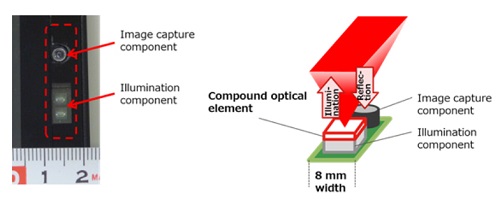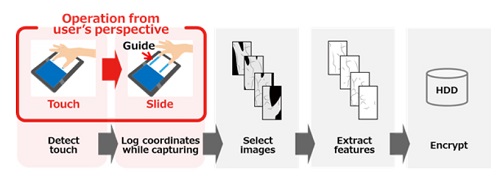|
Fujitsu Develops World's First Slide-Style Vein Authentication Technology Based on Palm Veins
8 mm wide optical unit can be equipped to tablets and other mobile devices
KAWASAKI, Japan, Jan 10, 2017 - (JCN Newswire) - Fujitsu Laboratories Ltd. has announced development of the world's first slide-style palm vein authentication technology. This technology is compact enough to be equipped to future tablets and other handheld mobile devices.
As tablets and other small-scale mobile devices have become widespread, there has been interest in embedding an optical unit for vein authentication into the narrow frames of such devices, but making the optical unit smaller had been difficult.
Fujitsu Laboratories has now taken strides to overcome this issue. It has succeeded in developing a compact illumination component that lights up a rectangular target area with a uniform intensity using a single LED. This was achieved by using a new compound optical element that applies the phenomenon of diffraction. The company has also developed a new verification technology that captures the complete pattern of a palm's veins, dividing the pattern into slices as the hand passes over the optical unit, which at a mere 8 mm wide is able to be embedded into the frames of compact mobile devices.
As a result, palm vein authentication-with its superior characteristics, including highly accurate authentication and the spoof-resistance offered by biological information from within the body-can be put to wider use, such as accessing personal or other sensitive information, or using services. The expectation is that this will lead to a corresponding prevalence of highly secure mobile services.
Background
 | | Figure 1: Prototype optical unit
(Left, photo: a dotted line surrounds the components; right, a schematic diagram) | | |
 | | Figure 2: How the new technology is used, and how it processes information | | |
Password-based authentication is increasingly seen as being vulnerable. Given this, biometric authentication technologies, in which a user confirms identity using a distinctive characteristic of their body or behavior, are becoming commonplace to prevent damage from data leaks or fraud. Fujitsu Laboratories has been a global leader in developing and deploying palm vein authentication technology, which has the benefits of using biological information within the body that is difficult to spoof.
In recent years, as working styles evolve in a variety of industries, the use of tablets and other mobile devices is spreading, and the devices are getting smaller. Given this, there has been a desire to equip these devices with even smaller palm vein authentication technology, which further improves security and simple operability, enabling corporate customers to use with peace of mind.
Issues
Palm vein authentication technology utilizes images captured by illuminating a palm with the safe near-infrared band light, which passes easily through the body, and reads vein patterns from the captured image. Accordingly, a palm vein authentication device's optical unit consists chiefly of an illumination component and an image capture component. In order to uniformly illuminate the entire palm, the illumination component, the widest part of the optical unit, is arranged to surround the image capture component. The issue, however, has been in making the component smaller. Moreover, if the image capture component is made smaller, the area that can be read on the palm veins becomes narrower, making authentication more difficult because the read area in palm veins is significantly different with every capture image when registering or verifying. As a result, it has been difficult to create technology that both enables the optical unit to be smaller and achieves accurate authentication.
About the Technology
In this world's first slide-style palm vein authentication technology, Fujitsu has miniaturized the optical unit to a mere 8 mm in width, allowing it to fit within the touch panel of mobile devices. This enables authentication simply by sliding one's fingers across the touch panel.
Key features of the technology are as follows:
1. Optical design technology for a uniformly lit, rectangular illumination area
Fujitsu Laboratories developed a compound optical element that utilizes optical diffraction to both scatter and focus light (Figure 1). The light radiated from the LED is diffracted to illuminate upwards diagonally, enabling illumination with uniform intensity over a rectangular area that is wider than the illumination component. By diffracting the light with uniform intensity at the rectangular area for image capture, the number of LEDs can be reduced. Moreover, by creating a structure in which the illumination component and the image capture component can be arranged in one row, Fujitsu Laboratories was able to create a size small enough to fit within the narrow width of a mobile device frame.
http://www.acnnewswire.com/topimg/Low_FujitsuPalmVeins11017Fig1.jpg
Figure 1: Prototype optical unit
(Left, photo: a dotted line surrounds the components; right, a schematic diagram)
2. Slide-style input with a finger stroke of the touch-panel, and an authentication algorithm
Users slide their fingers across the touch panel of the mobile device, and as the user's palm passes over the optical unit, which continuously captures images of the palm. At the same time, coordinate data obtained from the touch panel is also continuously recorded (Figure 2). Even though the optical unit's compact size results in a smaller capture area, because the hand passes over the optical unit, the pattern of palm veins is divided up for reading, enabling the entire palm vein pattern to be used for authentication. The guides make the captured area on the palm easier to reproduce. In addition, Fujitsu Laboratories developed a new algorithm for authenticating the divided-up palm vein patterns, verifying data using such features as image selection (false accept rate of 0.001%, and a one-retry false reject rate of 0.01%).
http://www.acnnewswire.com/topimg/Low_FujitsuPalmVeins11017Fig2.jpg
Figure 2: How the new technology is used, and how it processes information
Results
Using this newly developed technology, Fujitsu Laboratories has reduced the width of the optical unit for palm vein authentication to a mere 8 mm, achieving a size small enough to fit in the frame of tablets or other compact mobile devices that have narrow borders. Furthermore, combining a slide action with an authentication algorithm means verification just as dependable as current optical units.
Future Plans
Fujitsu Laboratories plans to continue refining its optical units and authentication algorithms with the goal of practical implementation of slide-style palm vein authentication technology during fiscal 2017. The company looks forward to expanding the use of palm vein authentication into new situations, thanks to new miniaturization techniques such as the compound optical element.
About Fujitsu Laboratories
Founded in 1968 as a wholly owned subsidiary of Fujitsu Limited, Fujitsu Laboratories Ltd. is one of the premier research centers in the world. With a global network of laboratories in Japan, China, the United States and Europe, the organization conducts a wide range of basic and applied research in the areas of Next-generation Services, Computer Servers, Networks, Electronic Devices and Advanced Materials. For more information, please see: http://www.fujitsu.com/jp/group/labs/en/.
Contact:Fujitsu Laboratories Ltd.
Knowledge Information Processing Laboratory
E-mail: sensor-bio-2017@ml.labs.fujitsu.com
Fujitsu Limited
Public and Investor Relations
Tel: +81-3-3215-5259
URL: www.fujitsu.com/global/news/contacts/
Source: Fujitsu Ltd
Sectors: Electronics
Copyright ©2024 JCN Newswire. All rights reserved. A division of Japan Corporate News Network. |
Latest Press Release

Mazda Production and Sales Results for March 2024 and for April 2023 through March 2024
Apr 25, 2024 18:21 JST
| 
MHI Begins Operation of SOEC Test Module the Next-Generation High-Efficiency Hydrogen Production Technology at Takasago Hydrogen Park
Apr 25, 2024 17:45 JST
| 
GAC Honda to Begin Sales of All-new e:NP2, the Second Model of e:N Series
Apr 25, 2024 16:50 JST
| 
Toyota Exhibiting at Beijing Motor Show 2024
Apr 25, 2024 16:25 JST
| 
Honda Reaches Basic Agreement with Asahi Kasei on Collaboration for Production of Battery Separators for Automotive Batteries in Canada
Apr 25, 2024 11:10 JST
| 
UNIQLO Sponsors KAWS + Warhol Exhibition Tour, Starting in Pittsburgh
Apr 25, 2024 09:00 JST
| 
Mitsubishi Power Begins Commercial Operation of Seventh M701JAC Gas Turbine in Thailand GTCC Project; Achieves 75,000 AOH To-Date
Apr 24, 2024 17:19 JST
| 
MC and Denka Sign J/V Agreement in Fullerene Business
Apr 24, 2024 17:02 JST
| 
Mitsubishi Motors Posts Record Sales in the Philippines in FY2023
Apr 24, 2024 13:56 JST
| 
NEC Develops High-speed Generative AI Large Language Models (LLM) with World-class Performance
Apr 24, 2024 13:25 JST
| 
Fujitsu SX Survey reveals key success factors for sustainability
Apr 23, 2024 10:25 JST
| 
Fujitsu and METRON collaborate to drive ESG success: slashing energy costs, boosting productivity with new manufacturing industry solutions
Apr 22, 2024 16:09 JST
| 
NEC Strengthens Commitment to Space Industry with Investment in Seraphim Space Venture Fund II
Apr 22, 2024 15:09 JST
| 
Soft Space Launches the First and Only JCB Payment Gateway in Malaysia
Apr 22, 2024 15:00 JST
| 
TOYOTA GAZOO Racing takes a one-two in Croatian thriller
Apr 22, 2024 10:47 JST
| 
First-ever Mazda CX-80 Crossover SUV Unveiled in Europe
Apr 19, 2024 13:50 JST
| 
Fujitsu develops technology to convert corporate digital identity credentials, enabling participation of non-European companies in European data spaces
Apr 19, 2024 10:17 JST
| 
Mitsubishi Heavy Industries and NGK to Jointly Develop Hydrogen Purification System from Ammonia Cracking Gas
Apr 18, 2024 17:01 JST
| 
Toyota Launches All-New Land Cruiser "250" Series in Japan
Apr 18, 2024 13:39 JST
| 
Fujitsu and Oracle collaborate to deliver sovereign cloud and AI capabilities in Japan
Apr 18, 2024 11:14 JST
|
More Latest Release >>
|